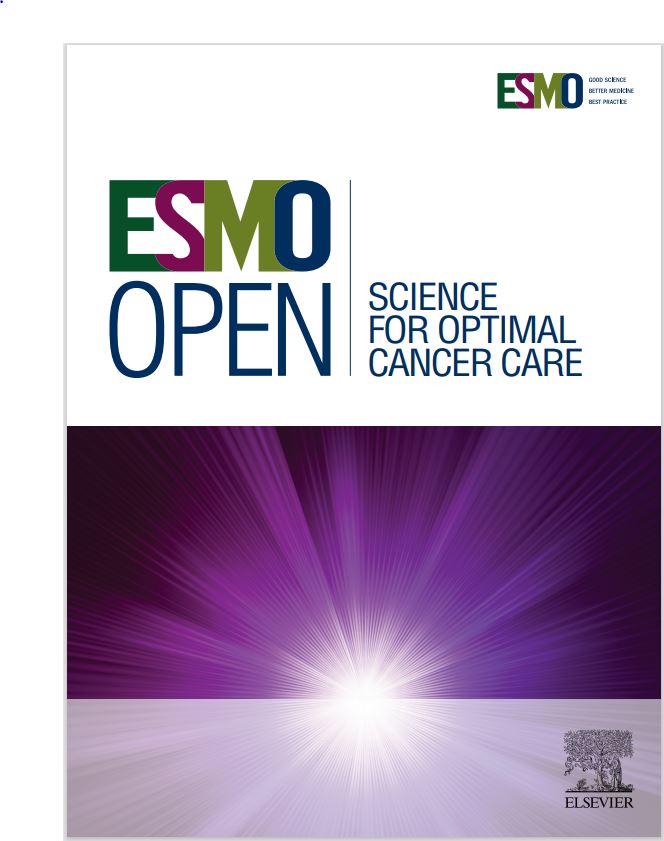早期her2阳性乳腺癌肿瘤浸润淋巴细胞与BMI的相互作用:ShortHER试验分析
IF 8.3
2区 医学
Q1 ONCOLOGY
引用次数: 0
摘要
我们在ShortHER试验中证实了肿瘤浸润淋巴细胞(til)在早期人表皮生长因子受体2 (HER2)阳性乳腺癌(eBC)患者中的预后作用。在这里,我们分析了身体质量指数(BMI)如何调节til的预后作用。患者和方法ShortHER研究将1253例her2阳性eBC患者随机分为9周和1年的辅助曲妥珠单抗+化疗。我们在诊断时评估BMI (n = 1213, n = 34体重过轻者被排除在外)。生存终点为无病生存期(DFS)、无复发生存期(RFS)、远端生存期(DDFS)和总生存期(OS)。我们通过竞争风险分析计算了第一事件类型的累积发生率。结果瘦583例(48%),超重360例(29.7%),肥胖236例(19.5%)。瘦弱患者与超重或肥胖患者的DFS、RFS、DDFS和OS相似。在TIL + BMI队列(n = 819)中,TIL(增加5%)与瘦患者的DFS (P = 0.003)、RFS (P = 0.001)和DDFS (P = 0.018)独立相关。在超重或肥胖患者中,TILs仅与DDFS独立相关(P = 0.044)。在瘦弱患者中,与TILs≥20%相比,TILs≥20%与DFS (P = 0.007)、RFS (P = 0.002)和DDFS (P = 0.027)改善相关。在超重或肥胖患者中,DFS、RFS、DDFS和OS在TILs≥20%和TILs <;20%之间无显著差异。在瘦弱患者中,TILs≥20%的患者局部复发(P = 0.001)和远处复发(P = 0.07)的累积发生率高于TILs≥20%的患者。在超重或肥胖患者中,TILs≥20%的患者远端复发累积发生率高于TILs≥20%的患者(P = 0.005)。结论:BMI可能会损害超重或肥胖her2阳性eBC患者接受辅助化疗+曲妥珠单抗治疗时TILs的局部保护作用,而不是远处保护作用。本文章由计算机程序翻译,如有差异,请以英文原文为准。
Interaction between tumor-infiltrating lymphocytes and BMI in early HER2-positive breast cancer: analysis of the ShortHER trial☆
Background
We demonstrated the prognostic role of tumor-infiltrating lymphocytes (TILs) in patients with early human epidermal growth factor receptor 2 (HER2)-positive breast cancer (eBC) enrolled in the ShortHER trial. Here, we analyze how body mass index (BMI) modulates the prognostic role of TILs.
Patients and methods
The ShortHER study randomized 1253 patients with HER2-positive eBC to 9 weeks versus 1 year of adjuvant trastuzumab + chemotherapy. We assessed BMI at diagnosis (available for n = 1213, n = 34 underweight were excluded). Survival endpoints were disease-free survival (DFS), recurrence-free survival (RFS), distant DFS (DDFS) and overall survival (OS). We calculated the cumulative incidence of first event types by competing risk analysis.
Results
A total of 583 (48%) patients were lean, 360 (29.7%) overweight and 236 (19.5%) obese. Lean patients versus those with overweight or obesity had similar DFS, RFS, DDFS and OS. Within the TIL + BMI cohort (n = 819), TILs (5% increase) were independently associated with DFS (P = 0.003), RFS (P = 0.001) and DDFS (P = 0.018) in lean patients. In patients with overweight or obesity, TILs were independently associated only with DDFS (P = 0.044). In lean patients, TILs ≥20% were associated with improved DFS (P = 0.007), RFS (P = 0.002) and DDFS (P = 0.027) compared with TILs <20%. In patients with overweight or obesity, DFS, RFS, DDFS and OS did not significantly differ between TILs ≥20% and TILs <20%. In lean patients, there was a higher cumulative incidence of locoregional relapse (P = 0.001) and distant relapse (P = 0.07) in patients with TILs <20% versus TILs ≥20%. In patients with overweight or obesity, there was a higher cumulative incidence of distant relapse (P = 0.005) in patients with TILs <20% versus TILs ≥20%.
Conclusions
We suggest that BMI may impair the local, but not distant, protective effect of TILs in patients with overweight or obesity with HER2-positive eBC treated with adjuvant chemotherapy + trastuzumab.
求助全文
通过发布文献求助,成功后即可免费获取论文全文。
去求助
来源期刊

ESMO Open
Medicine-Oncology
CiteScore
11.70
自引率
2.70%
发文量
255
审稿时长
10 weeks
期刊介绍:
ESMO Open is the online-only, open access journal of the European Society for Medical Oncology (ESMO). It is a peer-reviewed publication dedicated to sharing high-quality medical research and educational materials from various fields of oncology. The journal specifically focuses on showcasing innovative clinical and translational cancer research.
ESMO Open aims to publish a wide range of research articles covering all aspects of oncology, including experimental studies, translational research, diagnostic advancements, and therapeutic approaches. The content of the journal includes original research articles, insightful reviews, thought-provoking editorials, and correspondence. Moreover, the journal warmly welcomes the submission of phase I trials and meta-analyses. It also showcases reviews from significant ESMO conferences and meetings, as well as publishes important position statements on behalf of ESMO.
Overall, ESMO Open offers a platform for scientists, clinicians, and researchers in the field of oncology to share their valuable insights and contribute to advancing the understanding and treatment of cancer. The journal serves as a source of up-to-date information and fosters collaboration within the oncology community.
 求助内容:
求助内容: 应助结果提醒方式:
应助结果提醒方式:


